The Bengal Club will commemorate is bi-centenary year in 2027. As a build up towards this milestone year, many projects are being undertaken two years in advance to spruce up the institution to reinstate its splendour and glory in its 200th year.
The Chambers was no exception. The eleven existing rooms and one suite needed a complete upgrade as they are extremely popular with the members and their guests. The rooms are large each have an en-suite bathroom and a large attached balcony. Room sizes range from a minimum of 500 sq. ft to 700 sqft – a true luxury for the size of a room in one of the most prime locations in Kolkata.
The General Committee along with the Chambers Sub Committee decided to renovate and refurbish four rooms in 2023-24, four more in 2024-25 and the balance in 2025-26 so that come 1st Feb 2027, all of them will be upgraded.
To create a differentiator and uniqueness, it was decided to have a theme running for each of the rooms.
The first 4 rooms done in 2024 paid a tribute to the ‘Commodities of Bengal’ that resonate with Bengal such as Rice, Tea, Jute and Indigo. Subsequently the first four rooms named after each of these commodities showcased the colour and range of the same.
West Bengal's tea plantations are primarily concentrated in the northern part of the state, particularly in the districts of Darjeeling, Jalpaiguri, and Cooch Behar. These regions are famous for producing high-quality tea, with the Dooars and Darjeeling hills being major production areas. The industry is a vital part of the regional economy, providing livelihoods for hundreds of thousands of workers. India tea is famous for its first flush Darjeeling Tea.
This room pays tribute to Tea plantations of North Bengal and the colour palette is in Tea Green.
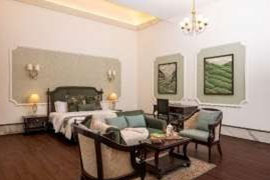
The Tea Room

The Tea Room
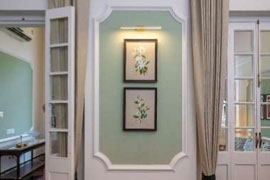
Another View of The Tea Room
West Bengal is India's largest rice-producing state, with rice cultivation taking place in all its districts, though it is most concentrated in areas like Bardhaman, Murshidabad, Nadia, and Hooghly. The state's favorable climate and fertile soil, particularly the Ganges delta, support the cultivation of three main crops: Aus, Aman, and Boro.
This room pays tribute to Rice Plantations of West Bengal and the colour palette is in shades of white.

The Rice Room
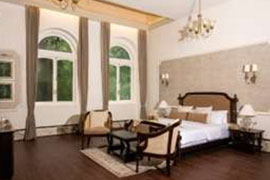
The Rice Room
West Bengal is India's leading jute-producing state due to its favorable hot and humid climate, ample rainfall, and rich alluvial soil found in the Ganges-Brahmaputra delta. Major jute-growing districts include 24 Parganas, Midnapur, Bardhman, Murshidabad, and Malda. The process requires significant water for retting, a step crucial for fiber extraction.
This room pays tribute to Jute Plantations of West Bengal and the colour palette is in shades of off white and beige.

The Jute Room – Bed Area
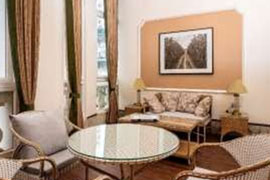
The Jute Room - Verandah
Indigo plantations were historically significant in West Bengal, especially in the 19th century, when they dominated the global market for blue dye. They were introduced in 1777 by a Frenchman named Louis Bonnaud and became a major commercial enterprise driven by European demand. The system was characterized by forced cultivation and unfavorable contracts for farmers, leading to the 1859-60 Indigo Rebellion (Neel Bidroho). Today, the remnants of this era can be seen in historical sites like the Maheshganj Estate.
This room pays tribute to Indigo plantations of Bengal and the colour palette is in Indigo Blue
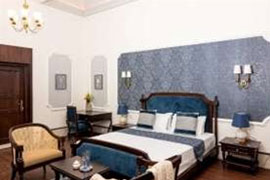
The Indigo Bedroom

The Indigo Room - Study Area

The Indigo Room - Verandah

The Indigo Room - Verandah
The next four rooms were undertaken in 2025 and paid a tribute to the ‘Legends of Bengal’. The thought being that these four rooms will create an ambience around the legend but not compromise on the comfort and privacy of the room. It was a delicate balance to create this milieu and not make it a museum that showcases the legends work. Colour themes, artifacts, furniture, lamps, painting, photographs, chandeliers, coffee table books were all researched and coordinated to make the room befitting the legend and his time.
Legends also had to be chosen who lend an aesthetic appeal to the décor of the room and would straddle the world of Art, Music, Culture and Heritage that the Bengal club is famous for. Care was taken to ensure that:
The Four Legends that were chosen were:
Our single goal was as follows: Skip boredom and give our Members and their Guests something to remember their stay at the legendary Bengal Club.
Rabindranath Thakur (7 May 1861– 7 August 1941) was a Bengali polymath who worked as a poet, writer, playwright, composer, philosopher, social reformer, and painter of the Bengal Renaissance. He reshaped Bengali literature and music as well as Indian art with Contextual Modernism in the late 19th and early 20th centuries. He was the author of the "profoundly sensitive, fresh and beautiful" poetry of Gitanjali. In 1913, Tagore became the first non-European to win a Nobel Prize in any category, and also the first lyricist to win the Nobel Prize in Literature. Tagore's poetic songs were viewed as spiritual and mercurial; where his elegant prose and magical poetry were widely popular in the Indian subcontinent. At the age of sixteen, he released his first substantial poems under the pseudonym ‘Bhānusiṃha’ ("Sun Lion"). As an exponent of the Bengal Renaissance, he advanced a vast canon that comprised paintings, sketches and doodles, hundreds of texts, and some two thousand songs; his legacy also endures in his founding of Visva-Bharati University. He was a fellow of the Royal Asiatic Society. Referred to as "the Bard of Bengal", Tagore was known by the sobriquets Gurudeb, Kobiguru, and Biswokobi. The Bengal Club pay tribute to this Legend of Bengal by dedicating this room in his honour.
A dramatic, oversized signature of Rabindranath Tagore crowns the wall above the bed — symbolic of the mark he left on world literature and the creative minds who will occupy this space.
Verdant emerald greens inspired by Santiniketan’s natural environs and the spiritual calm of his poetic universe.
Replica chandeliers from Jorasanko, terracotta and dokra art pieces, books by and on Tagore, and rare black-and-white portraits, including his meeting with Einstein.
The signature signifies genius, the artefacts evoke Tagore’s philosophy of nature and freedom, while the green tones mirror his belief in harmony between humanity and the environment.
Two vintage-style cane “araam kedar” armchairs on the verandah, reminiscent of his writing nook; solid wood furniture and handloom textiles lend a touch of Santiniketan simplicity.

The Tagore Room – Bed Area

The Tagore Room – Bed Area
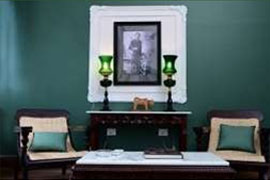
The Tagore Room - Verandah

The Tagore Room - Seating Area
Jamini Roy (11 April 1887 – 24 April 1972) was an Indian painter and one of the most famous pupils of Abanindranath Tagore, another praised Indian artist and instructor. Roy's highly simplified, flattened-out style, and reminiscent of European modern art was influenced by the “bazaar” paintings sold at Indian temples as talismans. He used indigenous materials like lamp black, organic tempera, earth and mineral pigments to paint. Initially he experimented with Kalighat paintings but found that it has ceased to be strictly a "patua" and went to learn from village ‘patuas’. Consequently, his techniques as well as subject matter was influenced by traditional art of Bengal. His underlying quest was threefold: to capture the essence of simplicity embodied in the life of the folk people; to make art accessible to a wider section of people; and to give Indian art its own identity.
Roy produced 20,000 paintings in his lifetime which is about 10 paintings daily but made sure his artistic aims remained the same. He was honoured by the Government of India with the award of Padma Bhushan in 1954. The Bengal Club pay tribute to this Legend of Bengal by dedicating this room in his honour.
A large, stylized signature of Jamini Roy above the bed sets the visual tone — bold, earthy, and deeply Indian.
Warm ochres, brick reds, deep blues, and ivory, drawn directly from his folk-inspired paintings.
Three framed reproductions of his iconic works, a hand-painted horse mural echoing his recurring motif, and artefacts inspired by Kalighat patachitra traditions.
The room embodies the democratization of art — the meeting of the folk and the modern — much like Jamini Roy’s own philosophy of simplicity and accessibility.
Cane-and-wood furniture with handwoven runners, earthy fabrics, and rustic lamps that emulate the ambience of a Bengal village atelier.

The Jamini Room - Bed Area

The Jamini Room - Artifact Shelf
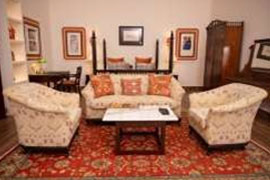
The Jamini Room – Seating Area

The Jamini Room - Verandah
Satyajit Ray (2 May 1921 – 23 April 1992) was an Indian film director, screenwriter, author, lyricist, magazine editor, illustrator, calligrapher, and composer. He is widely considered to be one of the greatest and most influential film directors in the history of cinema. Ray created two popular fictional characters in Bengali children's literature—Pradosh Chandra Mitter (Mitra), alias Feluda, a sleuth, and Professor Shonku, a scientist.
He also designed four typefaces for roman script named Ray Roman, Ray Bizarre, Daphnis, and Holiday script, apart from numerous Bengali ones for Sandesh magazine. Starting his career as a commercial artist, Ray was drawn into independent film-making after meeting French filmmaker Jean Renoir and viewing Vittorio De Sica's Italian neorealist film Bicycle Thieves during a visit to London. Ray directed 36 films, including feature films, documentaries, and shorts.
Ray's first film, Pather Panchali (1955), won eleven international prizes, including the inaugural Best Human Document award at the 1956 Cannes Film Festival. Ray received a record thirty-seven Indian National Film Awards which includes Dadasaheb Phalke Award, a Golden Lion, a Golden Bear, two Silver Bears and an Academy Honorary Award in 1992. The Government of India honoured him with the Bharat Ratna, its highest civilian award, in 1992. The Bengal Club pay tribute to this Legend of Bengal by dedicating this room in his honour.
A composition of black-and-white movie stills and original poster art from the Apu Trilogy celebrating Satyajit Ray’s cinematic mastery.
Monochrome — black, white, and grey — to mirror the timeless aesthetic of Ray’s early films.
A standing mirror reminiscent of Charulata, vintage binoculars, chess set, film clapboard, LP records, and the Feluda and Professor Shonku book collection.
This room celebrates observation — the gaze of the auteur — through mirrors, lenses, and reflections. The interplay of shadow and light pays homage to Ray’s visual storytelling.
Antique-style seating reminiscent of a film set, with heritage wood finishes, soft lighting, and accents that evoke mid-century Bengali homes.

The Ray Room – Bed Area

The Ray Room – Seating Area

The Ray Room – Verandah

The Ray Room - Mirror
This room was done with Twin Beds and therefore is a tribute to the Shankar brothers – Uday Shankar and Ravi Shankar
Uday Shankar (born 8 December 1900 – 26 September 1977) was an Indian dancer and choreographer, best known for creating a fusion style of dance, adapting European theatrical techniques to Indian classical dance, imbued with elements of Indian classical, folk, and tribal dance, which he later popularized in India, Europe, and the United States in the 1920s and 1930s. He was a pioneer of modern dance in India. In 1962, he was awarded by Sangeet Natak Akademi, India's The National Academy for Music, Dance and Drama, with its highest award, the Sangeet Natak Akademi Fellowship for lifetime achievement, and in 1971, the Govt. of India, awarded him its second highest civilian award the Padma Vibhushan. Uday Shankar did not have any formal training in any of the Indian classical dance forms. Nevertheless, his presentations were creative. From a young age, he had been exposed to both Indian classical dance and folk dance, as well as to ballet during his stay in Europe. He decided to bring elements of both styles together to create a new dance, which he called Hi-dance. He went on to translate classical Indian dance forms and their iconography to dance movements, after studying the Rajput painting and Mughal painting styles at the British Museum. The Bengal Club pay tribute to this Legend of Bengal by dedicating this room in his honour.
Ravi Shankar (7 April 1920 – 11 December 2012) was an Indian sitarist and composer. A sitar virtuoso, he became the world's best-known expert of Indian classical music in the second half of the 20th century, and influenced many musicians in India and throughout the world. Shankar was awarded India's highest civilian honour, the Bharat Ratna, in 1999. He spent his youth as a dancer touring India and Europe with the dance group of his brother Uday Shankar. At age 18, he gave up dancing to pursue a career in music, studying the sitar for seven years under court musician Allauddin Khan. After finishing his studies in 1944, Shankar worked as a composer, creating the music for the Apu Trilogy by Satyajit Ray, and was music director of All India Radio, New Delhi, from 1949 to 1956. He was nominated for the Academy Award for Best Original Score for scoring the blockbuster Gandhi (1982). He popularized performing on the bass octave of the sitar for the alap section and became known for a distinctive playing style in the middle and high registers that used quick and short deviations of the playing string and his sound creation through stops and strikes on the main playing string. The Bengal Club pay tribute to this Legend of Bengal by dedicating this room in his honour.
Twin beds aligned beneath portraits of Uday and Ravi Shankar, symbolizing the harmony of movement and music — two brothers, two arts, one rhythm.
Warm earth tones — deep reds, browns, and burnished golds — evoking the glow of stage lights and the energy of performance.
A pair of ghungroos, Ravi Shankar’s sitar photograph, and Uday Shankar’s dance pose from Kalpana, framed as central pieces.
Celebrates the globalisation of Indian performing arts — the fusion of East and West, classical and contemporary. The room becomes a metaphor for artistic dialogue and innovation.
Low seating, brass lamps, carved tables, and woven accents suggest an artist’s studio-meets-recital hall, blending comfort with performative flair.
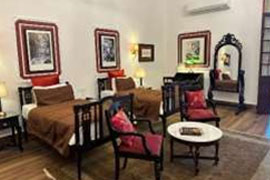
The Shankar Room – Bed Area

Study Area

The Shankar Room - Entrance

The Shankar Room - Verandah
The interior designs of the ‘Chambers Rooms’ at The Bengal Club trace a journey from the material to the mythical: from the ‘Commodities of Bengal’ that built its prosperity to the ‘Legends of Bengal’ who shaped its spirit. Together, they reflect the region’s timeless confluence of enterprise and excellence